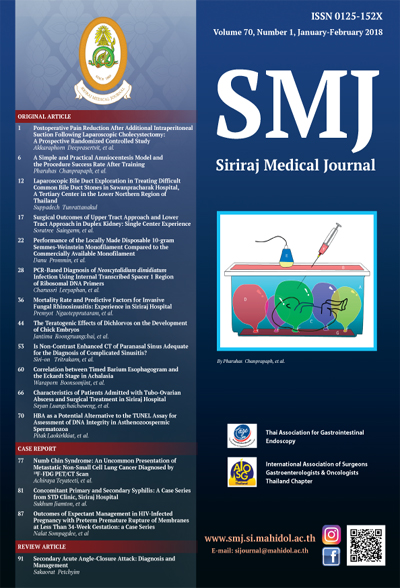A Simple and Practical Amniocentesis Model and the Procedure Success Rate After Training
Keywords:
Amniocentesis; success rate; training model; operative timeAbstract
Objective: To compare success rate of amniocentesis between model trained and non-model trained groups.
Methods: Siriraj amniocentesis simulator was practiced by 5 inexperienced obstetric residents. Forty aspirations of red solution from the targeted balloons using spinal needle number 20-G under the ultrasound guidance were performed. Thereafter, each trainee was allowed to perform the real amniocentesis under an expert supervision within a 5-minute period. Amniocentesis success rate of previous 5 non-model trained residents was retrospectively reviewed and considered as the control group.
Results: A comparison between each group was done to evaluate the success rate. There were 31 and 29 of amniocenteses performed by model trained and non-model trained groups, respectively. In comparison, the former had a non-significantly higher success rate (96.8% vs 82.2%; p > 0.05) with a significantly shorter operating time (34.27 + 21.7 vs 73.38 + 68.5 seconds; p < 0.05) than the latter. No obstetric adverse outcome was observed in both groups.
Conclusion: The amniocentesis-training program with model is beneficial for the beginners to develop their skill prior to the real practice, especially shorter operating time. There was a trend of higher success rate in the model-training group.
Downloads
Published
How to Cite
Issue
Section
License
Authors who publish with this journal agree to the following conditions:
Copyright Transfer
In submitting a manuscript, the authors acknowledge that the work will become the copyrighted property of Siriraj Medical Journal upon publication.
License
Articles are licensed under a Creative Commons Attribution-NonCommercial-NoDerivatives 4.0 International License (CC BY-NC-ND 4.0). This license allows for the sharing of the work for non-commercial purposes with proper attribution to the authors and the journal. However, it does not permit modifications or the creation of derivative works.
Sharing and Access
Authors are encouraged to share their article on their personal or institutional websites and through other non-commercial platforms. Doing so can increase readership and citations.











